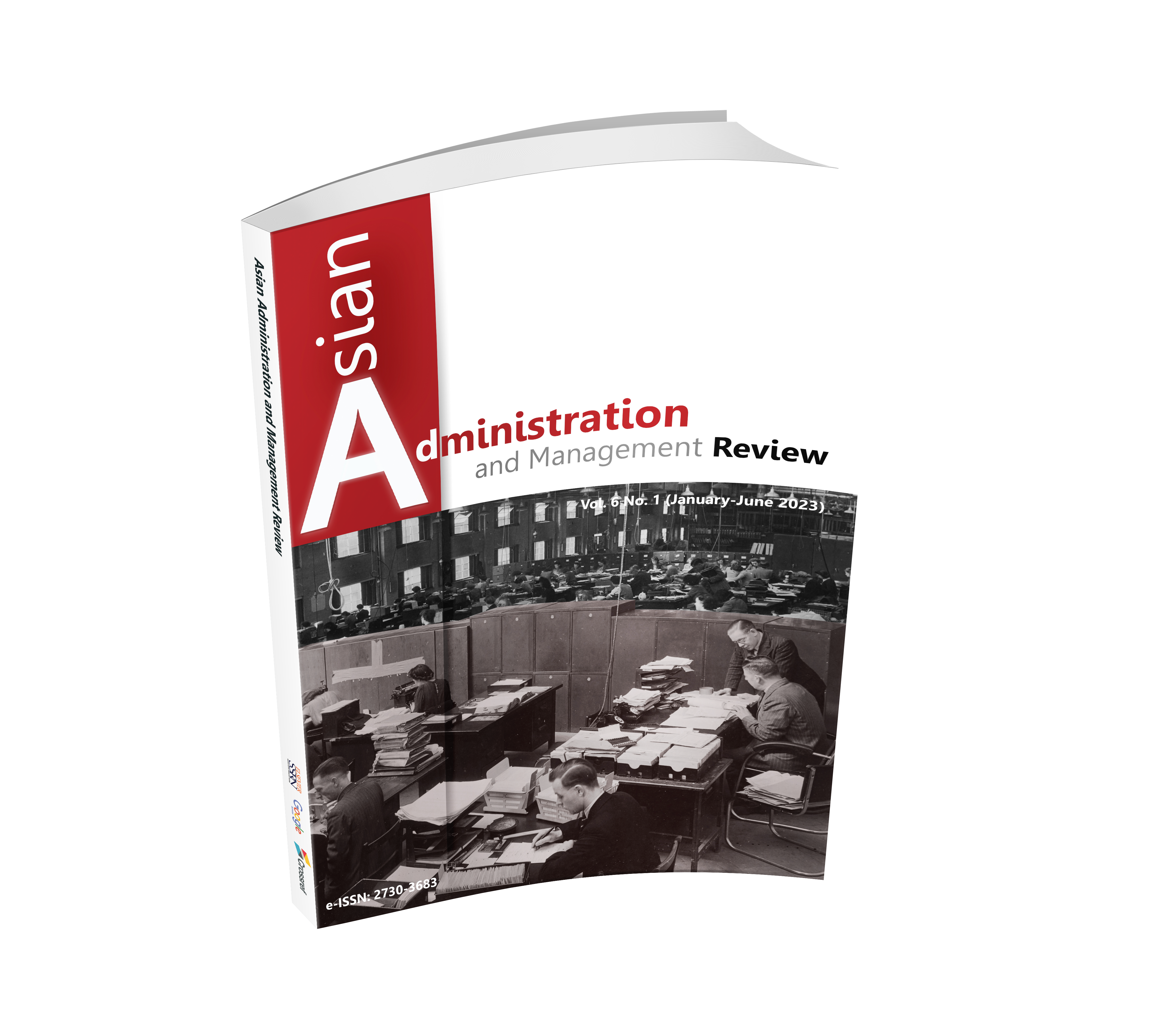GUIDELINES FOR IMPROVING THE ACHIEVEMENT OF SUSTAINABLE OTOP INNO-LIFE TOURISM COMMUNITY ENTERPRISES: EVIDENCE FROM THE LOWER NORTHEASTERN REGION OF THAILAND
DOI:
https://doi.org/10.14456/aamr.2023.12Keywords:
OTOP Inno-Life Tourism Community Enterprises, Tourism Community, Tourist Attraction, Product and Service, Marketing PromotionAbstract
The objectives of this research article are to identify factors that influence the achievement of sustainable OTOP inno-life tourism community enterprises and to offer the approaches in improving the achievement of sustainable OTOP inno-life tourism community enterprises. The quantitative data were collected from 300 members of community enterprises in the lower northeastern region of Thailand. In addition, 16 in-depth interviews were conducted with the group leaders of community enterprises and the district development officers. The results indicate that the achievement of sustainable OTOP inno-life tourism community enterprises in the mentioned area are at a high level. The factors influencing the achievement of sustainable OTOP inno-life tourism community enterprises include development of tourism communities, development of tourist attractions, development of products and services, and marketing promotion. Therefore, in improving the achievement of sustainable OTOP inno-life tourism community enterprises, all four factors need to be interconnected. The main goal is to create a community market to attract visitors, which, in turn, generates employment, increases income, and strengthens the grassroots economy. Nevertheless, entrepreneurs must receive vocational training to produce quality products and services.
Downloads
References
Aeknarajindawut, N., Boonphadung, S., & Rungsawanpho, D. (2019). Antecedents of the Success of OTOP Navatwithi Tourism Village Project in Phrae Province. Journal of MCU Peace Studies, 7(6), 1776-1785.
Akarawong, S., Sangduen, N., U-soh, A., & Gothamasan, P. (2019). Tourism for (Quality of) Life. Journal of Southern Technology, 12(2), 216-227.
Anusuren, N., & Lowatcharin, G. (2019). An Assessment of OTOP Nawatwithi Community Based Tourism under the Thai Niyom Yangyuen Program in Khon Kaen Province. Journal of Buddhist Education and Research, 5(2), 205-221.
Armstrong, G., & Kotler, P. (2009). Marketing, An introduction. 9th ed. New Jersey: Pearson Prentice Hall.
Boomsma, A., & Hoogland, J. (2001). The Robustness of LISREL Modeling Revisited. In R. Cudeck, S. du Toit, & D. Sörbom. (eds.). Structural Equation Models: Present and Future (pp. 139-168). Illinois: Scientific Software International.
Bootcharee, A., & Lowatcharin, G. (2021). An Evaluation of the “Nawatwithi OTOP” Community Tourism in Sakon Nakhon Province. Academic Journal of Mahamakut Buddhist University Roi Et Campus, 10(1), 449-461.
Bureau of Local Wisdom and Community Enterprise Promotion. (2017). Marketing promotion of OTOP Nawatwithi tourism community. Bangkok: Community Development Department.
Chaopraeknoi, U. (2019). Evaluation of OTOP Nawatwithi Tourism Community Project in Samutsakhon Province. Journal of Graduate School, 16(75), 157-168.
Chotpittayanon, N. (2023). The Development of OTOP Inno-Life Tourism Community Enterprises for Enhancing Quality of Life. Journal of MCU Social Science Review, 12(2), R14-R27.
Chupan, P. (2010). Is it true that Thai tourism is only 6% of GDP?. Retrieved from www.scbeic.com/th/detail/product/355.
Community Development Department, Ministry of Interior. (2018). OTOP Inno-Life Tourism Community Project Management Manual. Bangkok: Community Development Department.
Daothong, K. (2021). Implementation of OTOP Nawatwithi Tourism Community Policy: A case study of Khlong Phra Udom Subdistrict Lat Lum Kaeo District Pathum Thani Province. Master of Public Administration Thesis. Chulalongkorn University.
Data Innovation and Governance Institute. (2023). Revealing statistics on the tourism situation in Thailand. Retrieved from https://digi.data.go.th/showcase/thailand-tourism-statistics/#:~:text=ภาคการท่องเที่ยวเป็นหนึ่ง,800%2C000%20ล้านบาทเท่านั่น.
Daungprom, D., Srisunthron, C., T.srivong, A., & Auyapitang, V. (2022). Guidelines for Increase Potential Nawatwithi OTOP Tourism Community Ban Tungyung, Udonthani Province. The Journal of Development Administration Research, 12(3), 500-510.
Hemaphan, P. (2022). The Success of OTOP Tourism Villages: Process and Institutional Entrepreneurship. Journal of Community Development and Life Quality, 10(1), 22-34.
Investerest.co. (2020). How important is the tourism business to the Thai economy?. Retrieved from www.investerest.co/economy/travel-business-and-thai-economy.
Jaihan, P., Nalao, A., & Kidkhamsuan, W. (2023). Management Guidelines of OTOP Inno-Life Tourism for Strengthening Community in Nakhon Phanom Province. Journal of Social Science Panyapat, 5(2), 41-56.
Jankomol, T. (2019). Thai tourism is an important engine driving the Thai economy. Retrieved from www.kasikornbank.com/th/personal/the-wisdom/articles/Pages/Special-Report_Onward28_2019.aspx.
Khaosod. (2018). CDD accelerates the drive for the "OTOP Nawatwithi Tourism Community", highlighting innovation combined with way of life. Retrieved from www.khaosod.co.th/politics/news_1036678.
Khongphan, P., Taiwan, A., & Sitthijirapat, P. (2023). The Development of Creative-Tourism Management on the OTOP Nawatwithi Tourism Community in Phathalung Province Using the EDFR Process. Narkbhutparitat Journal, 15(1), 79-91.
Komalamisr, B., Saengla, P., Phrakhrupariyattikittiwong, Chantamalo, P., Malawangso, P., & Dhammawet, C. (2019). The Development of Community Innovations for the 12th National Strategic Plan. Journal of Buddhist Studies Vanam Dongrak, 6(1), 77-90.
Krungthai Compass. (2023). Open a new world of tourism in the post-COVID era with GIFT+ tourists. Bangkok: Krungthai Compass.
Longtunman. (2021). The Thai economy will never return to the way it was before if tourism does not recover. Retrieved from www.longtunman.com/32225.
Mahavanakul, W., & Prasongsak, N. (2023). How is Thai tourism recovering spatially?. Retrieved from www.bot.or.th/th/research-and-publications/article/chaengsibia/article-2023jun13.html#:~:text=ภาคการท่องเที่ยวเป็นหนึ่ง,ฟื้นตัวของภาคการท่องเที่ยว.
Nathamphloi, C. (2019). Achievement Management in Current Social Society. Journal of Educational Innovation and Research, 3(3), 171-178.
Nuansara, M., Teypinsai, N., & Chutinatphuwadon, C. (2021). Guideline for the Development of OTOP and Brand Product to International Standards Chiang Rai Province. Dusit Thani College Journal, 15(1), 119-134.
Office of Community-based Tourism. (2018). Sustainable tourism development. Bangkok: Designated Areas for Sustainable Tourism Administration (Public Organization).
Phayakvichien, P. (2014). Development of community-based tourism networks for sustainable tourism development. Bangkok: Office of Tourism Development.
Phonginwong, R., Huadsir, K., Thipaksorn, C., Eaimviriyawat, K., & Sawangtap, R. (2019). Factors Affecting the Success of the Inno-Life Tourism Based Communities: A Case Study of Bannmai Village, Sawai Chik Sub-district, Mueang District, Buriram Province. Academic Journal of Buriram Rajabhat University, 11(1), 117-131.
Poolsawat, W., Youngrod, N., & Imdee, P. (2021). Developing a strong community network to promote Nawatwithi tourism of the Lao Khrang ethnic groups in Nakhon Pathom province. RMUTSB Academic Journal (Humanities and Social Sciences), 6(2), 194-211.
PPTVHD36. (2020a). Shattering the dream of OTOP Nawatwithi, 9 billion dissolves the river. Retrieved from www.pptvhd36.com/news/ประเด็นร้อน/130093.
PPTVHD36. (2020b). The community complained that the "Otop Nawatwithi Project" did not reach its dreams and that the budget was taken back. Retrieved from www.pptvhd36.com/news/ประเด็นร้อน/130319.
Qun, L., Leelapattana, W., Trakansiriwanich, K., Waiapha, Y., & Sitthikun, S. (2022). Market Mix Factors Affecting Thai Tourists' Decision to Use Small and Medium-Sized Hotels under the Critical Conditions of the Covid-19 Pandemic in Chiang Mai, Thailand. Asian Administration and Management Review, 5(2), 77-85.
Sathirathai, S. (2023). 'Remaking tourism - 4 big problems for the Thai economy'. Retrieved from www.thaipost.net/articles-news/409234/.
SCB Wealth. (2019). How strong is tourism, the heart of the Thai economy?. Retrieved from https://thestandard.co/thailands-economy-tourism/.
Schumacker, R., & Lomax, R. (2010). A beginner’s guide to structural equation modeling. 3rd ed. New Jersey: Lawrence Erlbaum Associates.
Senakhan, T., & Pavapanunkul, S. (2022a). Applying the Compassionate Love for the Passion to Achieve Transformation towards Creative Tourism of Chainat Provincial Administrative Organization, Thailand after Covid-19 Endemic. PSAKU International Journal of Interdisciplinary Research, 11(2), 126-134.
Senakhan, T., & Pavapanunkul, S. (2022b). Strategic Model of Creative Tourism after COVID Endermic of Chainat Provincial Administrative Organization, Thailand. Asian Political Science Review, 6(2), 22-32.
Sermchayut, R. (2020). Promotion Strategy for Community Based Tourism. Journal of Multidisciplinary Academic Research and Development, 2(4), 51-61.
Sriayut, K., & Bunjoon, O. (2021). Participation of OTOP Tourism Community at Ban Ton Pho, Pathumthani Province for Sustainable Tourism. Journal of Humanities and Social Sciences Bansomdejchaopraya Rajabhat University, 15(2), 33-63.
Srithong, S., Suthitakon, N., & Karnjanakit, S. (2019). Participatory Community-based Agrotourism: A Case Study of Bangplakod Community, Nakhonnayok Province, Thailand. PSAKU International Journal of Interdisciplinary Research, 8(1), 212-220.
State Audit Office of the Kingdom of Thailand. (2020). Report on the inspection of the achievement and efficiency of the operation of the OTOP Nawatwithi Tourism Community Project. Bangkok: State Audit Office of the Kingdom of Thailand.
Swangkong, K., Tatiyanantakul, W., & Subhimaros, P. (2022). Sustainable Management of Community-Based Tourism, OTOP INNO-LIFE: A Process and Successful Story of Ban Koh-Kerd Community, Bang Pa-In, Phra Nakhon Si Ayutthaya Province. Journal of Legal Entity Management and Local Innovation, 8(1), 362-373.
Technology and Informatics Institute for Sustainability. (2019). 10-Year Framework of Programmes on SCP. Retrieved from www.nstda-tiis.or.th/our-rd-activities/sd-data/10yfp-scp/sustain_tourism/.
Thai PBS. (2019). Looking back at the origins of the OTOP Nawatwithi tourism community project. Retrieved from www.thaipbs.or.th/news/content/282767.
Thailand Community Based Tourism Institute. (2021). Get to know community-based Tourism. Chiang Mai: Thailand Community Based Tourism Institute.
Thanawachiranun, P., Jaipeng, C., Rujivararat, N., & Deeponpun, C. (2021). The Development Guidelines of Sanamchan Community Nakhon Pathom Province according to OTOP Inno-Life Tourism Community. Payap University Journal, 31(2), 134-147.
Tourism Authority of Thailand. (1998). The role of the tourism industry in the overall economy of the country. Bangkok: Tourism Authority of Thailand.
Tourism Authority of Thailand. (2018). Community-based Tourism: Discover Thainess, Chic & Sustainable. Retrieved from https://tatreviewmagazine.com/article/community-based-tourism/.
Tourism Authority of Thailand. (2023). 9 new trends in the future of tourism. Bangkok: Tourism Authority of Thailand.
TTB Analytics. (2023). TTB Analytics expects Thai tourism revenue in 2023 to increase by 1 trillion baht from the previous year. Retrieved from www.ttbbank.com/th/newsroom/detail/travel-thailand-2566.
Wattanakul, S., Ekiem, B., Panyadee, C., & Techatunminasakul, S. (2023). The Strategy of OTOP Nawatvithi Community Tourism Development for Banpatan, Buak Khang Sub-DistrictSan Kam Phaeng District, Chiang Mai Province. School of Administrative Studies Academic Journal, 6(2), 102-119.
Woravat, T., Kanaphum, S., & Kosonkittiumporn, S. (2019). Factors Affected the Strength of Nawatwithi OTOP Tourism Community in Nakhon Ratchasima Province. NEU Academic and Research Journal, 9(2), 71-80.
World Bank. (2023). Thailand Economic Monitor: Coping with Droughts and Floods; Building a Sustainable Future. Bangkok: World Bank.

Downloads
Published
How to Cite
Issue
Section
License
Copyright (c) 2023 Authors

This work is licensed under a Creative Commons Attribution-NonCommercial-NoDerivatives 4.0 International License.











.png)


